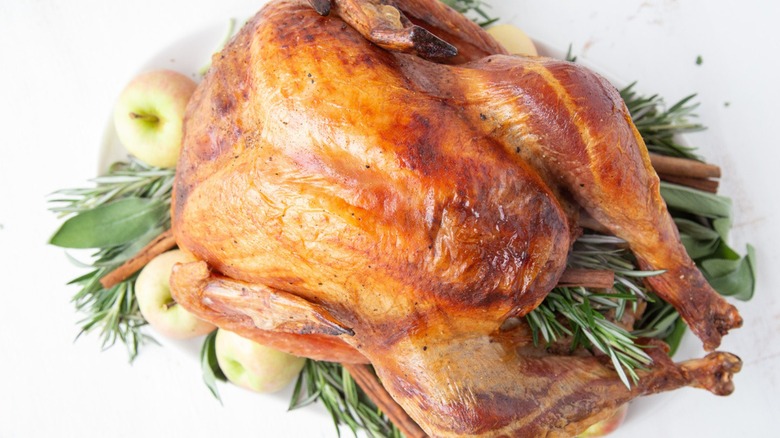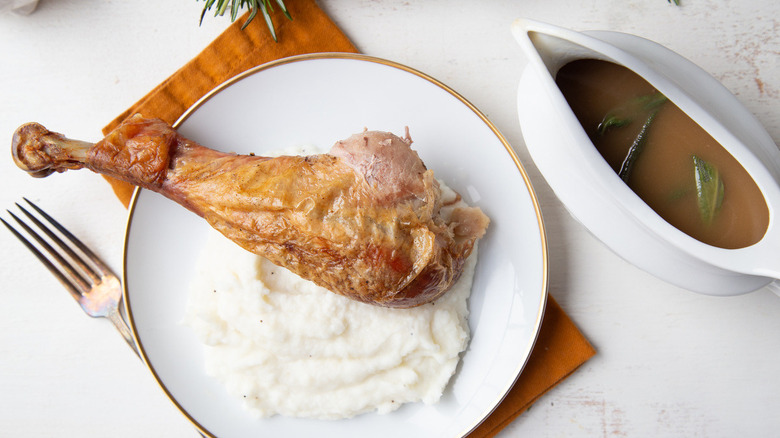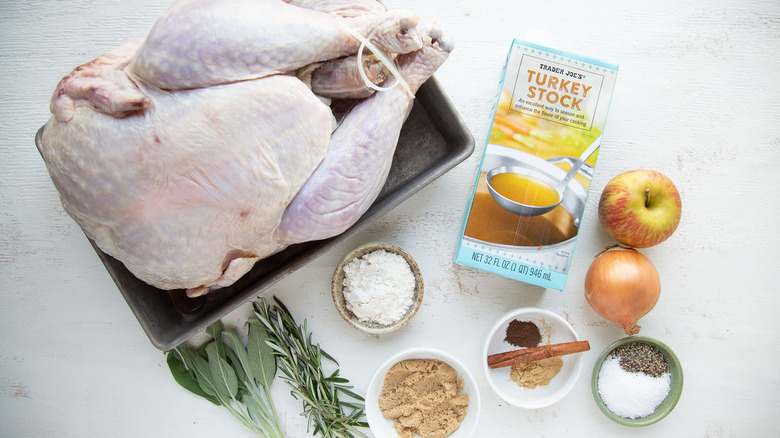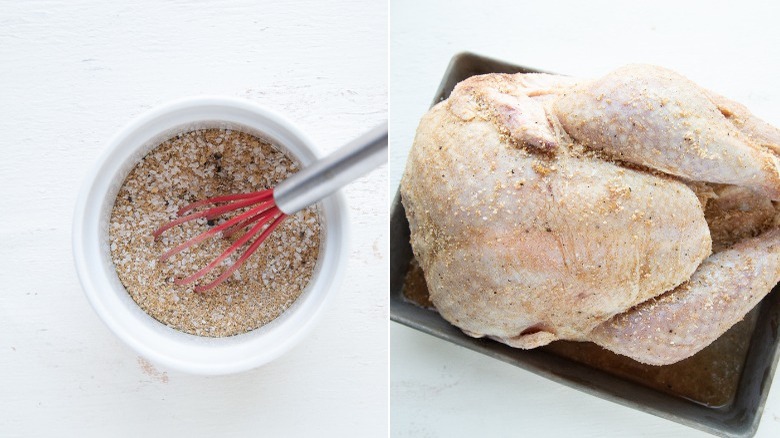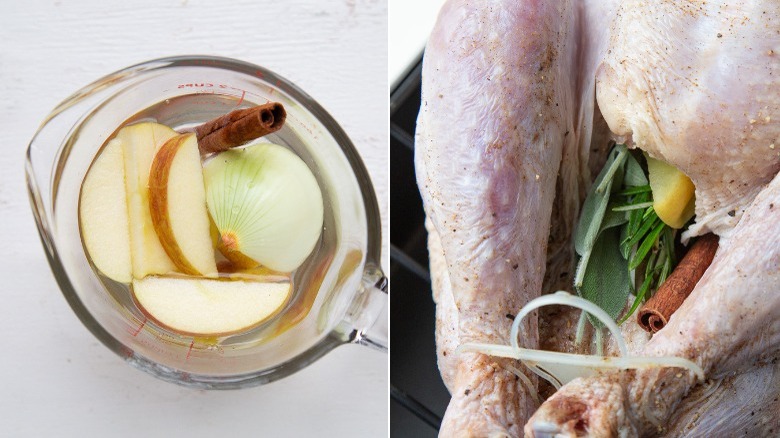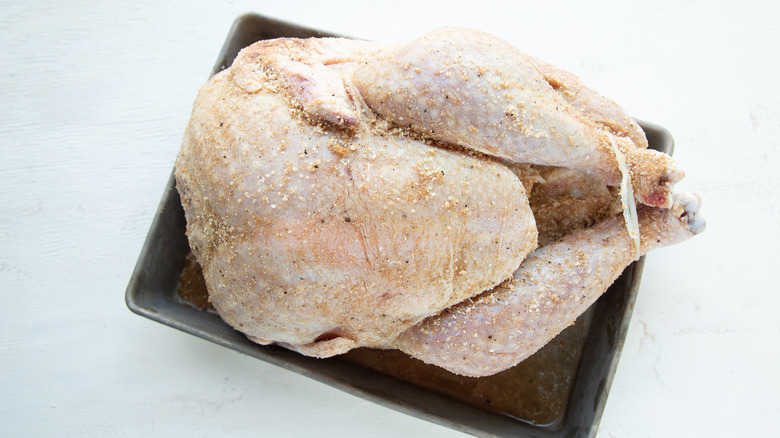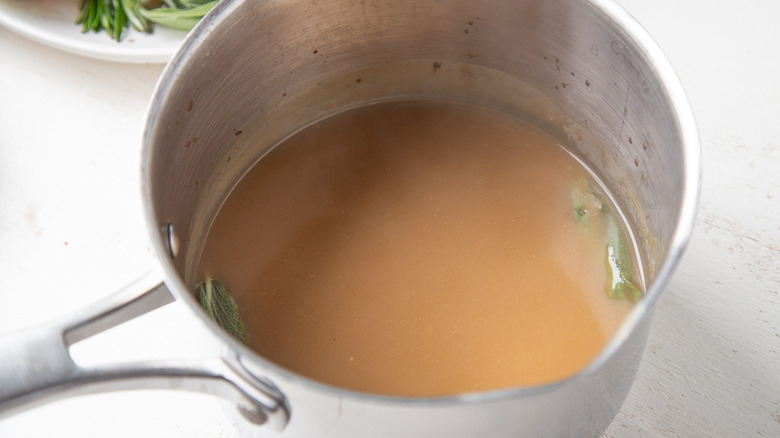Alton Brown's Good Eats Roast Turkey Recipe With A Twist
Mashed recipe developer Kate Shungu, the food blogger behind Gift of Hospitality, knows a really good thing when she sees it, but she's also not afraid to try to make a really good thing even better. That brings us to what Shungu has done here with Alton Brown's wet-brined "Good Eats" roast turkey recipe (via Food Network). "I knew this recipe had all of the right techniques" that would result in tender, juicy, and flavorful turkey with crispy skin, she explains to Mashed. However, Shungu also believes that, with a few twists, she can get the same results while also ending up with a savory, aromatic gravy to accompany the turkey. (Hello, multitasking efficiency!) Not to mention, it avoids some of the arduous and messy aspects of wet brining.
We'll explain each of Shungu's innovative twists in a bit more detail below. All you need to know for the moment is that you won't have to deal with wet-brining, and that if you live in a multi-resident setting such as an apartment or attached condo community, your neighbors will be thanking you. Keep reading to learn the how, the why, and everything else you'll need to master this Thanksgiving classic-to-be.
What did we change?
Shungu adapts Brown's basic recipe by deploying a deeply flavorful and wonderfully concentrated dry brine in lieu of Brown's wet brine. Shungu has considerable experience making turkey both ways (wet versus dry brine), and has found that the dry brine is so much "less [messy] and easier to do in the refrigerator." Also, Shungu builds in a much-needed mini-recipe for turning the "jus" — the juices that cook off the turkey during the roasting process — into a satisfying sage-scented gravy.
The final (and genius, if you don't mind us saying so) twist here is that Shungu slightly tweaks Brown's roasting method, which involves starting the turkey at the very high heat of 500 F for a half-hour before lowering the heat to a gentler 350 F. Shungu feels that the same results can be achieved (crispy-outside, tender and juicy-inside) without setting off your kitchen's smoke alarm, simply by starting at 450 F. It also helps to rid your oven of any residue before you start roasting, Shungu points out.
Gather your ingredients for the roast turkey
For Shungu's twist on Alton Brown's recipe for "Good Eats Roast Turkey", you'll need a 14 to 16 pound frozen young turkey. For optimal results, you will want to steer clear of any turkey that has been pre-injected with seasonings or pre-brined in any way (such as Butterball). It's not that those can't be delicious, it's just that this recipe imbues its own aromatic flavor into the turkey — both from the inside and the outside, as Shungu explains to Mashed.
For the outside-in flavor, Shungu employs a dry brine that calls for three tablespoons of kosher salt, 1 tablespoon of ground black pepper, 2 tablespoons of brown sugar, 1 teaspoon of ground ginger, and ¼ teaspoon of ground allspice. For the inside-out flavor, you'll be using aromatics in the turkey's cavity. These will include 1 red apple, a sliced ½ onion, 1 cinnamon stick, 4 sprigs of fresh rosemary, 10 sage leaves, canola oil, and water.
Finally, for the gravy (which practically makes itself by the way), you'll need 2 cups of low sodium chicken or turkey stock and a bit of all-purpose flour (cornstarch works for gluten-free cooking). Tools you will need include a roasting pan, a roasting rack to insert in the roasting pan, an oven-safe poultry thermometer, and a saucepan for the gravy.
Get your turkey off to a good start with this dry brine
Before you begin, you'll need to defrost your turkey — if it's frozen. To do that, take the turkey out of its packaging, and remove any giblets or other packets from the cavity. Cover and place the turkey in your refrigerator for three to four days, setting the giblets aside to defrost separately. When you're ready to start brining, place the turkey on top of a roasting rack in a roasting pan that's big enough to comfortably hold the turkey but can still fit in your refrigerator. In a small bowl, combine the kosher salt, black pepper, brown sugar, ground ginger, and ground allspice. Rub the mixture all over the turkey including inside the cavity. Place the turkey in the prepared pan and refrigerate for 24 to 48 hours.
Prepare your aromatics and stuff them in the turkey cavity
When you're ready to cook the turkey, preheat your oven to 450 F. Remove the turkey from the refrigerator and wipe off the excess dry brine with wet paper towels. Place the aromatics — the sliced apple, onion, cinnamon stick, along with 1 cup of tap water in a microwave-safe dish, and microwave them for five minutes. Strain the apple, onion, and cinnamon stick from the hot water, and transfer them to the turkey's cavity. Add the rosemary and six sage leaves to the cavity, as well.
Truss the turkey and get it roasting
Rub the outside of the turkey with canola oil (this part is really important, Shungu emphasizes, particularly if you care about crispy golden turkey skin). Tuck the wings underneath the turkey, and use twine to tie the legs together (if the turkey did not come that way when you bought it).
Roast the turkey at 450 F for 30 minutes — set a timer so that you can't possibly forget. When the timer goes off, reduce the heat to 350 F. Insert an oven-safe thermometer into the thickest part of the breast. Bake the turkey for two and a half hours more. At the end of the duration, use an instant-read thermometer to measure from one of the breasts. If the meat has reached the safe temperature of 161 F, then remove the turkey from the oven and transfer it to a cutting board to rest for 15 minutes. If the turkey has not yet reached 161 F, then give it up to another 30 minutes in the oven.
Make the sage gravy for this turkey
To make the sage gravy for Alton Brown's "Good Eats" roast turkey recipe with a twist, start by pouring the turkey drippings from the bottom of the roasting pan into a measuring cup. Pour ½ a cup of the drippings into a saucepan. Add 1 ½ cups of stock and the four remaining sage leaves.
In a jar with a tight-fitting lid, combine the remaining ½ cup of stock and the flour, and shake to form an easy roux. Add the roux to the saucepan and cook for two minutes, whisking occasionally to break up any lumps. Remove the sage leaves if desired. Carve the turkey and serve it with the sage gravy.
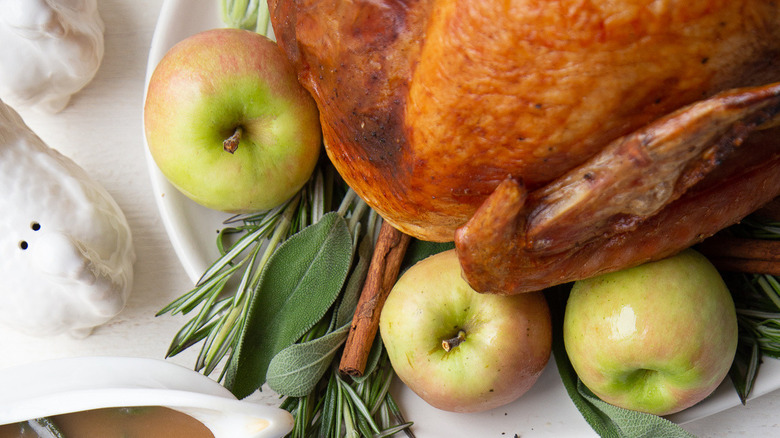
- 1 (14–16 pound) frozen young turkey
- 3 tablespoons kosher salt
- 1 tablespoon ground black pepper
- 2 tablespoons brown sugar
- 1 teaspoon ground ginger
- ¼ teaspoon ground allspice
- 1 red apple, sliced
- ½ onion, sliced
- 1 cinnamon stick
- 1 cup water
- 4 sprigs rosemary
- 10 sage leaves, divided
- canola oil, to coat the turkey skin before roasting
- 2 cups low sodium chicken or turkey stock, divided
- 2 tablespoons all-purpose flour
- Defrost the turkey in the refrigerator for 3 to 4 days before you begin.
- Remove the turkey from its packaging, remove any giblets or packets from the cavity, and pat the turkey dry with paper towels.
- Place a rack on top of a roasting pan or sheet pan (make sure that it will fit in your refrigerator).
- In a small bowl, combine the kosher salt, black pepper, brown sugar, ground ginger, and ground allspice.
- Rub this dry brining mixture all over the turkey, including inside the cavity.
- Place the turkey in the prepared pan, and refrigerate for 24 to 48 hours.
- When you're ready to cook the turkey, remove it from the refrigerator, and dab it with wet paper towels.
- Preheat the oven to 450 F.
- Place the sliced apple, onion, cinnamon stick, and water in a microwave-safe dish, and microwave for 5 minutes.
- Strain the apple, onion, and cinnamon stick from the hot water, and transfer them to the turkey cavity.
- Add the rosemary sprigs and 6 sage leaves to the cavity as well.
- Rub the outside of the turkey with canola oil.
- Tuck the wings underneath the turkey, and tie the legs together with twine.
- Roast the turkey at 450 F for 30 minutes.
- Reduce the oven temperature to 350 F, and insert an oven-safe thermometer into the thickest part of the breast.
- Bake the turkey for an additional 2 hours or more — just until the thermometer reaches 161 F.
- Remove the turkey from the oven.
- Transfer the turkey to a cutting board, and let it sit for 15 minutes.
- Pour the turkey drippings from the roasting pan into a measuring cup.
- Pour ½ cup of the drippings into a saucepan.
- Add 1 ½ cups of turkey or chicken stock and the 4 remaining sage leaves, and bring to a boil.
- In a jar with a tight-fitting lid, combine the remaining ½ cup of stock and the flour.
- Shake until the mixture is smooth.
- Add this easy roux to the saucepan, and cook for 2 minutes, whisking occasionally to break up any lumps.
- Remove the sage leaves, if desired.
- Carve the turkey, and serve with the sage gravy.
Nutrition
| Calories per Serving | 836 |
| Total Fat | 38.9 g |
| Saturated Fat | 8.2 g |
| Trans Fat | 0.3 g |
| Cholesterol | 349.3 mg |
| Total Carbohydrates | 10.2 g |
| Dietary Fiber | 1.6 g |
| Total Sugars | 5.0 g |
| Sodium | 1,848.3 mg |
| Protein | 106.3 g |
